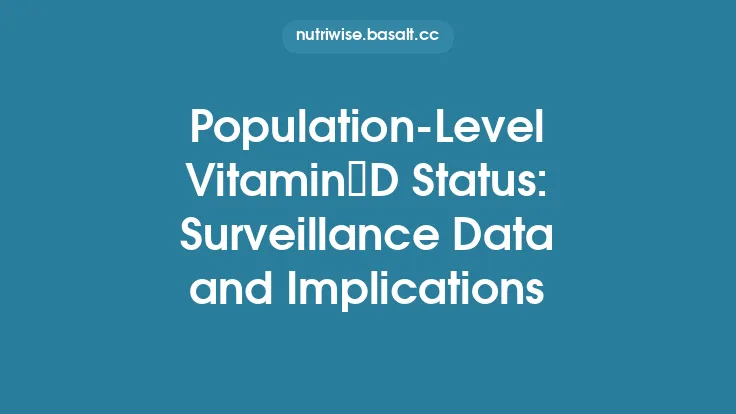Vitamin D, often dubbed the “sunshine vitamin,” plays a pivotal role in calcium homeostasis, bone health, immune modulation, and a host of metabolic processes. Over the past several decades, epidemiologists have amassed a wealth of data revealing striking patterns in vitamin D status across diverse populations. These patterns are shaped by a complex interplay of geographic, demographic, behavioral, and environmental factors, and they carry profound implications for public‑health planning, clinical practice, and research priorities. The following synthesis distills the most robust, evergreen insights from the epidemiologic literature, highlighting methodological considerations, key determinants, health outcomes, and emerging surveillance strategies.
1. Methodological Foundations for Assessing Vitamin D Status
Biomarker of Choice
The circulating concentration of 25‑hydroxyvitamin D [25(OH)D] remains the gold‑standard indicator of vitamin D status. It reflects total input from cutaneous synthesis, dietary intake, and supplementation, and it has a half‑life of approximately 2–3 weeks, providing a stable measure for population surveys.
Assay Standardization
Historically, variability among immunoassays, high‑performance liquid chromatography (HPLC), and liquid chromatography–tandem mass spectrometry (LC‑MS/MS) hindered comparability across studies. The Vitamin D Standardization Program (VDSP) now offers reference‑material protocols that align assay results to a common calibration hierarchy, markedly improving cross‑study reliability.
Cut‑off Definitions
Consensus thresholds (endorsed by the Institute of Medicine and the Endocrine Society) categorize 25(OH)D concentrations as follows:
- Deficiency: <20 ng/mL (50 nmol/L)
- Insufficiency: 20–29 ng/mL (50–74 nmol/L)
- Sufficiency: ≥30 ng/mL (≥75 nmol/L)
While these cut‑offs are widely used, emerging data suggest that optimal levels may be context‑specific, varying with age, ethnicity, and disease risk.
Survey Designs
Large‑scale, cross‑sectional surveys (e.g., NHANES in the United States, the Canadian Health Measures Survey, and the European ENIDE project) provide snapshots of population status. Longitudinal cohort studies (e.g., the UK Biobank, the Framingham Heart Study) enable assessment of temporal trends and causal inference regarding health outcomes.
2. Geographic and Seasonal Determinants
Latitude and Solar Irradiance
The most consistent epidemiologic finding is the inverse relationship between latitude and mean 25(OH)D concentrations. Populations residing above ~37° N or below ~37° S experience markedly lower wintertime levels due to reduced UVB photons capable of catalyzing cutaneous vitamin D synthesis.
Seasonality
Seasonal fluctuations are pronounced in temperate zones, with peak concentrations in late summer (July–August) and troughs in late winter (January–February). The amplitude of this oscillation can exceed 10 ng/mL in high‑latitude cohorts, underscoring the need for season‑adjusted reference ranges in surveillance.
Altitude
Higher altitude can partially offset latitude effects because thinner atmospheric layers allow greater UVB penetration. Studies from the Andes and the Himalayas demonstrate modestly higher 25(OH)D levels at elevations >2,500 m compared with adjacent lowland areas, after controlling for sun exposure behavior.
3. Demographic Influences
Age
- Infants and Young Children: Breastfed infants whose mothers have low vitamin D status are at heightened risk of deficiency, prompting universal supplementation recommendations in many countries.
- Older Adults: Age‑related skin thinning reduces cutaneous synthesis efficiency by up to 50 % after age 70, contributing to the high prevalence of insufficiency among the elderly, especially in institutional settings.
Sex and Hormonal Status
Women of reproductive age often exhibit lower 25(OH)D levels than men, a disparity partly attributable to higher body fat percentages and, in some cultures, more conservative clothing practices. Post‑menopausal women may experience a modest rise in circulating levels due to reduced estrogen‑mediated hepatic clearance.
Ethnicity and Skin Pigmentation
Melanin acts as a natural sunscreen; individuals with darker skin require 2–3 times longer sun exposure to generate equivalent vitamin D amounts as lighter‑skinned counterparts. Epidemiologic surveys consistently report higher deficiency rates among African‑American, South Asian, and Indigenous populations in high‑latitude nations.
Body Mass Index (BMI)
Obesity is associated with a volumetric dilution effect: vitamin D, being fat‑soluble, is sequestered in adipose tissue, lowering its bioavailability in circulation. Meta‑analyses estimate a 1 ng/mL reduction in 25(OH)D for each unit increase in BMI.
4. Behavioral and Lifestyle Modifiers
Sun Exposure Practices
- Outdoor Activity: Time spent outdoors, especially during midday, is the strongest predictor of serum 25(OH)D in epidemiologic models.
- Clothing and Cultural Norms: Full‑body coverings, common in certain religious or cultural contexts, dramatically limit UVB exposure.
- Sunscreen Use: While sunscreen effectively prevents erythema, routine application of SPF 30 can reduce cutaneous vitamin D synthesis by up to 95 % if applied liberally.
Dietary Sources
Natural food sources (fatty fish, cod liver oil, egg yolk) contribute modestly to total vitamin D intake. Fortified foods (milk, plant‑based milks, breakfast cereals) have become pivotal in regions where sunlight is insufficient, and epidemiologic data show higher serum levels among regular consumers of fortified products.
Supplementation Patterns
Self‑reported supplement use varies widely: >40 % of older adults in the United States report regular vitamin D supplementation, whereas usage rates are <10 % in many low‑ and middle‑income countries. Randomized trials embedded within cohort studies have demonstrated that supplementation of 800–2,000 IU/day can raise 25(OH)D by ~10–20 ng/mL, effectively shifting many deficient individuals into the sufficient range.
5. Health Outcomes Linked to Vitamin D Status
Skeletal Health
Deficiency is unequivocally linked to rickets in children and osteomalacia in adults. Large prospective cohorts have shown a dose‑response relationship between low 25(OH)D and increased risk of hip and vertebral fractures, particularly in the elderly.
Immune Function and Infectious Diseases
Observational studies consistently report higher rates of respiratory infections among individuals with 25(OH)D <20 ng/mL. Meta‑analyses of randomized controlled trials suggest that supplementation reduces the incidence of acute upper respiratory tract infections, especially in those with baseline deficiency.
Metabolic and Cardiovascular Disease
The epidemiologic evidence is mixed. While low vitamin D status correlates with higher prevalence of hypertension, type 2 diabetes, and metabolic syndrome in cross‑sectional analyses, Mendelian randomization studies have not confirmed a causal link, indicating potential confounding by adiposity and lifestyle factors.
Cancer
Ecological and case‑control studies have identified inverse associations between vitamin D levels and colorectal cancer incidence. However, randomized trials (e.g., VITAL) have yielded modest, non‑significant reductions, suggesting that vitamin D may act as a modest adjunct rather than a primary preventive agent.
Neurocognitive and Mood Disorders
Low 25(OH)D has been associated with increased risk of depression and cognitive decline in older adults. Longitudinal data indicate that maintaining sufficient levels may attenuate age‑related cognitive trajectories, though interventional evidence remains limited.
6. Surveillance Systems and Data Integration
National Health Surveys
Many high‑income countries incorporate 25(OH)D measurement into periodic health examinations (e.g., NHANES, Health Survey for England). These datasets enable trend analysis, identification of high‑risk subpopulations, and evaluation of policy impacts (e.g., fortification mandates).
Electronic Health Records (EHRs)
Linking laboratory data with demographic and clinical information in EHRs offers a real‑time lens on vitamin D status. Machine‑learning algorithms can flag patients at risk of deficiency based on predictors such as age, BMI, season, and medication use (e.g., glucocorticoids).
Geospatial Modeling
Combining satellite‑derived UVB irradiance data with population demographics yields high‑resolution maps of predicted vitamin D synthesis potential. These models have been validated against measured 25(OH)D concentrations and are valuable for targeting public‑health interventions.
Biobanks and Genetic Data
Large biobanks (UK Biobank, All of Us) provide genotype‑phenotype datasets that facilitate Mendelian randomization and gene‑environment interaction studies, deepening our understanding of the biological pathways linking vitamin D to disease.
7. Public‑Health Interventions and Policy Implications
Food Fortification
Mandatory fortification of staple foods (e.g., milk, margarine, flour) has demonstrably increased population 25(OH)D levels in several countries. Dose‑response modeling suggests that fortifying at 400 IU per serving can raise mean serum concentrations by ~5 ng/mL, reducing deficiency prevalence by 20–30 %.
Supplementation Guidelines
Consensus recommendations now endorse routine vitamin D supplementation for groups at high risk of deficiency: infants (400 IU/day), pregnant and lactating women (600–800 IU/day), older adults (800–2,000 IU/day), and individuals with limited sun exposure. Implementation studies highlight the importance of provider education and affordable supplement access.
Sun‑Safe Strategies
Balancing skin‑cancer prevention with adequate vitamin D synthesis is a nuanced public‑health challenge. Guidelines encourage short, regular midday sun exposure (e.g., 10–15 minutes for light‑skinned individuals) while maintaining protective measures for prolonged outdoor activities.
Monitoring and Evaluation
Effective programs incorporate baseline and follow‑up assessments of serum 25(OH)D, dietary intake surveys, and compliance tracking. Cost‑effectiveness analyses consistently show that fortification and targeted supplementation yield favorable health‑economic ratios, especially when preventing fractures and related healthcare costs.
8. Future Directions in Vitamin D Epidemiology
- Integrative “Omics” Approaches – Combining metabolomics, epigenomics, and microbiome data with vitamin D status may uncover novel mechanistic pathways and identify subgroups that benefit most from optimization.
- Precision Public Health – Leveraging geospatial UVB data, individual risk scores, and wearable UV sensors could enable personalized sun‑exposure recommendations while preserving population‑level surveillance.
- Longitudinal Cohorts in Low‑ and Middle‑Income Settings – Expanding high‑quality vitamin D data beyond high‑income nations will clarify global burden, especially in regions where fortification is limited and cultural practices affect sun exposure.
- Randomized Implementation Trials – Pragmatic trials that test fortification levels, supplement dosing, and delivery mechanisms (e.g., community health worker distribution) will provide actionable evidence for policymakers.
- Standardized Reporting Frameworks – Adoption of VDSP protocols across all national surveys will ensure comparability, facilitate meta‑analyses, and improve the reliability of trend estimates over time.
In sum, the epidemiologic landscape of vitamin D status is characterized by robust, reproducible patterns driven by geography, demography, behavior, and physiology. While deficiency remains a pervasive public‑health concern, especially among high‑latitude, darker‑skinned, and older populations, a suite of evidence‑based interventions—ranging from food fortification to targeted supplementation—has proven effective in narrowing the gap. Continued investment in standardized surveillance, integrative research, and precision‑focused policies will be essential to sustain progress and translate vitamin D insights into tangible health gains worldwide.




